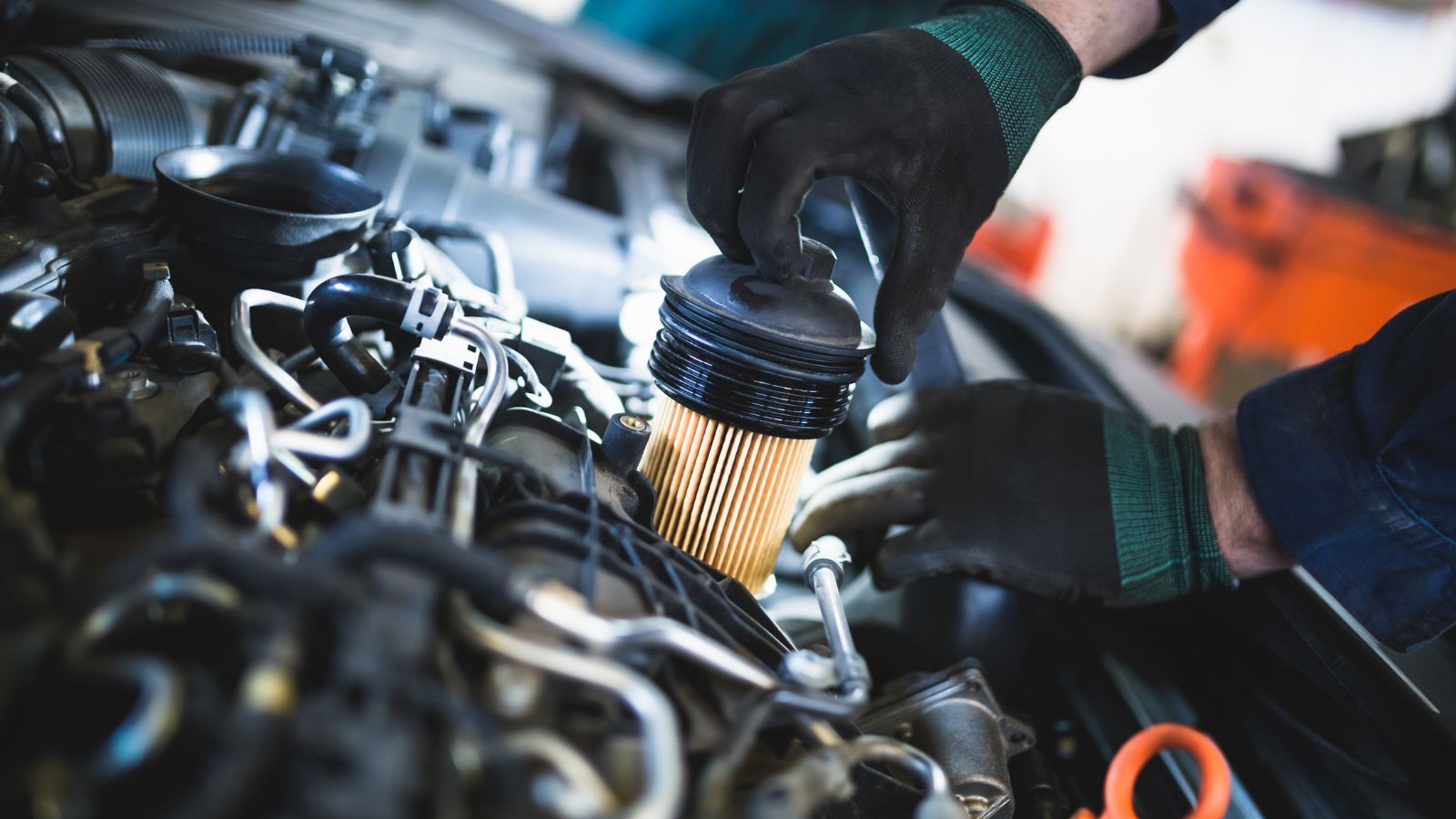It’s unusual that you own an automobile and have no difficulties. Most truck owners face trouble after changing the 6.7 Powerstroke fuel filter. And it cost them too much time to find the solution of 6.7 Powerstroke fuel filter change problems.
After changing the fuel filter, the most common problem is the vehicle takes time to start. It happens because of insufficient fuel supply. To fix this problem, disconnect the tube from the vessel’s surface. Then install a fuel pressure sensor on it. Connect the pipe to the fuel filter and open some valves on the top. Keep the fuel pressure around 60 and 80 PSI.
Insufficient flow of fuel is not the only problem you’ll face. More issues can be a headache for you when you change the fuel filter. To know all of them along with their solutions, keep scrolling the page.
Table of contents
5 Most Common 6.7 Powerstroke Fuel Filter Change Problems
A good fuel filter captures dirt, dust, and other impurities while enabling enough gasoline to enter the motor. However, it fails to perform properly at some point.
You may notice symptoms like reduced performance when dragging or going upward. Difficult startings, trembling stutters, slow speed, or a vehicle reluctance often emerge when you push the steering wheel.
As a result, it must be altered.
Here are the five most common 6.7 Powerstroke fuel filter change problems that you may face:
1. Harsh Engine
After changing the fuel filter, the engine may run harshly. Several people might report that their system runs harshly after changing the gasoline filter. The machine is frequently deprived of gasoline, which causes this difficulty.
Since you would have a replacement fuel filter installed, most of you would rule out that possibility.
If your automobile drives erratically after a fuel filter replacement, it’s possible that the fuel filter was installed incorrectly. There might be difficulties to control in particular.
As a result, your fuel filter may not be receiving energy from your engine.
2. No Fuel Supply
It may be tough to begin or have no fuel supply after replacing the fuel filter. The problematic beginning is the second most prevalent issue after replacing the entire filter.
Whenever the car rests for even a short period, such as 30 seconds before cranking, it might still be tough to begin.
Even if the filter still functions, an insufficient fuel supply won’t let the vehicle start.
3. Broken Fuel Filter
Most people complain that their fuel filter is not running after replacement, or the filter isn’t working.
If your fuel filter is fitted incorrectly, you could experience issues, such as insufficient ability to continue or operate your vehicle, as well as leakage from the foundation of your container.
The most typical explanation for this is that an electrical cable is obstructing the path. That’s because the fuel filter adapter was placed in the wrong way, causing your fuel filter to go into the motor or the other way around.
4. Irregular Fuel Gauge
You may discover your fuel gauge is displaying irregularly after replacing the entire fuel filter. It’ll alternate between being blank and being filled.
As the reservoir closes to empty, the suction in a replacement fuel filter lowers.
You can replace your gasoline filter in one of two methods, either repair the filter and engines separately or the entire container, including the fuel pressure, transmitting component. The fuel pressure transferring element is most likely the blame.
How to Fix Problems Caused By 6.7 Powerstroke Fuel Filter Change
As you’ve seen the problems, now let’s talk about some solutions so that you don’t need to face the problems again.
1. If the Engine Runs Harshly
You’ll have to double-check whether your electricity program’s controls are adequate and that they’re making an excellent interface with their equivalents on or within the vehicle.
2. If you Face Problematic Beginning or No Fuel Supply
Disconnect the tube from the vessel’s surface that connects to the fuel filter. After that, mount a fuel pressure sensor on it.
Connect the pipe to the filter via a connector. For airflow, start opening several of the valves on the top.
The fuel pressure ought to be around 60 and 80 PSI, although it can range from 45 to 55 PSI in some types. While completing this procedure, check your car’s manual for the correct volumetric efficiency.
3. If the Fuel Filter is Broken
You’ll find that this happens more often with replacement components than with parts and accessories. Test all of your intake manifolds to ensure that no cables are hindering your fuel filter connector.
Having no fuel in the pipe means a pressure leakage. If the pump encounters too much opposition, it’ll spin for extended periods until it achieves sufficient fuel incentive to change.
Your engine starts must remain consistent, assuming there were no difficulties with the electrical connection along its route.
Moreover, people can still identify ignition switch problems and use an OBD II analyzer with a fuel filter gauge. You should learn about two methods for checking fuel pressure without a meter.
Next, check the circuit that regulates the fuel filter to see whether it receives any electricity through the car’s power circuit.
4. For Irregular Fuel Gauge
If you’ve just changed the fuel filter and engine, you might want to consider changing the transmitting components as well.
When there’s an entirely fitted fuel chamber, you probably require a higher-quality transmitting component. High heat and pressure from gasoline can damage fuel transmitting devices.
This might lead them to dissolve more commonly than they otherwise would, resulting in inconsistent gas measurements.
When Should You Replace Your Fuel Filter?
The fuel filter is vital for proper fuel efficiency, and it’s mean to filter out dirty contaminants when they approach the engine, ensuring that only purified fuel is used.
However, fuel filters should be replaced after 20,000 to 150,000 miles, according to most automakers. The older your car is, the more frequently you must check the filters. That’s because corrosion, dust, and particles develop away quicker after seven years of driving, blocking the filter.
But some say after 30,000 miles, it’s a good idea to replace your car’s fuel filter. Many individuals, meanwhile, replace theirs after 40,000 miles. It would be best if you choose a suitable endurance range of 30,000 to 40,000 miles.
Don’t be like those strange drivers who don’t replace their fuel filter until it’s blocked or damaged. Modifications to gasoline injections and carbureted engines distinguish today’s cars.
As a result of these enhancements, diesel engines are more susceptible to dust, which clogs passageways and damages the engine. Injector damage can cause gasoline discharge to alter from a spray to a faint trickle, disrupting the complete combustion.
Previously, it was suggested that the gasoline filter be replaced every 20,000 to 30,000 miles. Filters may now be changed every 60,000 miles, thanks to advancements in fuels and today’s automobiles. Recheck your car’s manual or discuss with a reputable technician to identify the best time to change your fuel filter.
Potential Complications After Changing the Fuel filter and How to Avoid Them
Knowing the problems and solutions won’t do your job totally. Some other things you’ve to keep in mind and they’re:
- Before replacing the fuel filter, double-check all interconnections. Ensure that they’re in excellent shape with other tools.
- While changing a fuel filter, choose higher-quality components. Once it’s charging up, low-quality elements could create issues affecting your implementing sustainability.
- Whenever the fuel is low, and the car rests even for short durations, apply decent quality fuel pressure transmitting devices to avoid your ride from behaving weirdly.
- Carefully inspect your freshly fitted fuel filter on a fuel injection system. Check for any faulty connectors.
- Precisely operate the replacing task in a safe zone, such as your garage or basement, rather than on a busy road.
Frequently Asked Questions
- How frequently must the fuel filter be changed On a 6.7 Powerstroke?
Answer: It’s advised to replace each third annual service or every 15000 miles, whatever occurs first, or as directed by the confirmation email.
- How much would it cost to replace the fuel filters on a 6.7 Powerstroke?
Answer: A replaceable fuel filter for a Ford F-250 Super Duty costs around $111 and $154. Labor expenses are anticipated to be about $55 and $70, with component costs ranging from $56 to $84. The quantity and age of Ford F-250 Super Duty trucks on the highway determine this category.
- How long does a 6.7 Powerstroke engine last?
Answer: The 6.7L Power Stroke has proved that it can easily surpass the 200,000-mile milestone with minimal maintenance through years of development. There’s no explanation this engine can’t go 300,000 or even 400,000 miles if you follow Ford’s suggested basic package.
- Is it possible to BulletProof a 6.7 Powerstroke?
Answer: The BulletProof 6.7 Powerstroke oil coolers have been far more significant than Ford’s OEM oil cooler, providing substantially more operating temperature. It’s a perfectly suitable alternative for this component, quick and uncomplicated to repair.
Conclusion
Unless the fuel filter has been the only issue with your automobile, replacing this will restore it to new condition. The 6.7 Powerstroke fuel filter change problems are so common in vehicles.
Therefore, if your car continues to malfunction after the gasoline filter has been replaced, the freshly fitted filter may be defective.
As a result, you must examine the replacement filter to verify that it is not destroyed or blocked in either form.

Thomas is a retired motor mechanic, father, and grandfather. He writes from his 20+ years in the automotive industry to help you find and solve anything related to car repairs, maintenance, and care.
